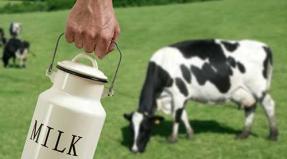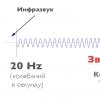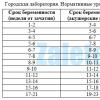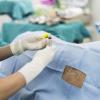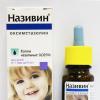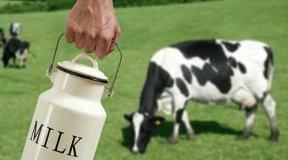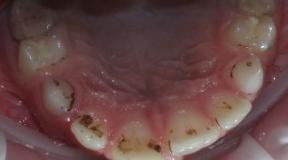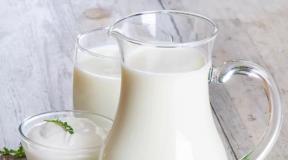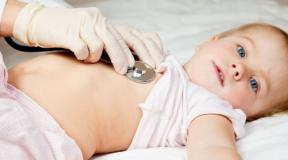Vaccination against Marek's disease. Vaccines for chickens (Newcastle disease, etc.): application and advice. Step-by-step instructions for vaccination against Marek's disease
1. Vaccine against Marek’s disease “AVIVAC-Marek”, dry culture with diluent
2. The vaccine is a homogeneous, dry, finely porous mass of white-yellow color. The AVIVAC-Marek vaccine is made from a cell culture of quail embryo fibroblasts infected with turkey herpesvirus (VHI strain FS-126), disintegrated by ultrasound and freeze-dried with the addition of a stabilizer, which includes solutions of sucrose and gelato in a buffer. One immunizing dose of the vaccine is 2000 FFU.
The vaccine is supplied complete with a diluent (“AVIVAC-Marek Diluent”), which includes a phosphate buffer solution pH 7.0-7.4, sucrose, peptone, phenol red. In appearance, the diluent is a transparent orange-red liquid. One dose of diluent is 0.2 cm3.
The vaccine is produced in glass vials (500-2000 doses each). The bottles are sealed with rubber stoppers reinforced with aluminum caps. The diluent is packaged in glass bottles. The bottles are sealed with rubber stoppers reinforced with aluminum caps. Vials of the vaccine are packaged in cardboard or plastic boxes of 10-100 pieces with nests or partitions to ensure their immobility and integrity. Each box contains instructions for using the vaccine.
3. The shelf life of the vaccine is 12 months from the date of manufacture. The diluent's shelf life is 24 months from the date of manufacture. It is prohibited to use the vaccine and diluent after the expiration date.
4. The vaccine is stored and transported in a dry, dark place at a temperature of 2 to 6°C, the diluent at a temperature of 8 to 12°C.
5. The vaccine and diluent must be stored out of the reach of children.
6. Vials without labels, with a violation of the integrity and tightness of the closure, altered color and consistency of the contents, with the presence of foreign impurities, in the absence of a label, as well as with a vaccine not used within 30 minutes after dilution, are subject to rejection and disinfection by boiling for 30 min with subsequent disposal. Disposal of the thinner does not require special safety measures.
P. BIOLOGICAL PROPERTIES
7. In vaccinated chickens, the vaccine causes the formation of immunity to Marek’s disease on the 14th day, which lasts for life. The infectious activity of the vaccine must be at least 2.5x105 FFU/cm3.
III. ORDER OF APPLICATION
8. The vaccine is used to immunize chickens in farms that are safe, endangered, and unaffected by Marek’s disease in various areas of cultivation.
9. Only clinically healthy birds are subject to vaccination.
10. Chickens are vaccinated once in the first hours of life, directly in the hatchery in a specially adapted room. The vaccine is administered intramuscularly using syringes or special automatic injectors into the area of the upper third of the inner thigh or subcutaneously into the area of the upper third of the neck in a volume of 0.2 cm. If you have Ovojek injection equipment, it is recommended to administer the drug directly into the embryo on the 18th day of incubation.
Vaccination
Vials with diluent in the amount required for vaccination are kept for 8-12 hours at a temperature of 18-25 ° C before use.
Before vaccination, 2.0 cm3 of diluent is added to the vaccine vial using a sterile syringe. After resuspension, the vaccine is combined with the main volume of diluent.
The contents of the vaccine bottles are dissolved in one bottle of diluent at the rate of: 200.0 cm3 - 1000 doses; at 400.0 cm3 - 2000 doses.
Vials with diluted vaccine are protected from exposure to direct sunlight and heat.
During vaccination, vials with diluted vaccine are shaken periodically without the formation of foam.
Before vaccination, syringes and needles are sterilized by boiling in distilled water for 10-15 minutes, and injectors that are not subject to boiling are disassembled, cleaned, washed with cooled boiled water, disinfected with a 70° solution of ethyl alcohol and flambéed.
11. The indicated modes of use exclude the possibility of drug overdose.
12. The vaccine does not cause a clinically significant reaction.
13. During the first 3 weeks, vaccinated chickens are kept isolated from birds of other age groups.
IV. PERSONAL PREVENTION MEASURES
14. All persons participating in vaccination must wear special clothing (robe, trousers, hat, rubber gloves). During vaccination, drinking water and food, and smoking are prohibited.
15. If the vaccine gets on exposed skin of the hands and face, as well as mucous membranes, it is recommended to rinse them with plenty of tap water. In the event of a vaccine spill, the contaminated area of the floor or soil is filled with a 5% solution of chloramine or sodium hydroxide.
16. If the drug is accidentally administered to a person, he should contact a medical facility and inform the doctor about it.
The vaccine is made from strains of attenuated Marek's disease virus (MDV), avirulent chicken herpesvirus (CHV) and turkey herpesvirus (TVH) in mono-, bi- and polyvalent versions. The vaccine is available in liquid and lyophilized form:
from VGI serotype III – “AVIVAC-MAREK-3”, liquid;
from VBM serotype I + VBM serotype III – “AVIVAC-MAREK -1+3”, liquid;
from EBM serotype I + EBM serotype II + EBM serotype III – “AVIVAC-MAREK -1 +2+3”, liquid;
from VGI serotype III – “AVIVAC-MAREK-3”, lyophilized.
The liquid vaccine is a column of frozen homogeneous mass with a horizontal meniscus; when thawed, it becomes a homogeneous suspension of yellow-pink color.
The dry vaccine is a homogeneous, finely porous, cylindrical mass of white-yellow color.
The liquid vaccine is produced with a special diluent "AVIVAC-MAREK", which is a buffered solution with stabilizing components, in the form of a transparent red liquid. For the lyophilized (dry) vaccine from VGI "AVIVAC-MAREK-3" the diluent is "Diluent of virus vaccine against Marek's disease, culture dry from VGI FS-126" TU 9384-010-00482915-01 or "Diluent for concentrated virus vaccines" TU 9384-001 -50195182-00.
Subject to the rules of transportation, storage, use of the drug, as well as veterinary, sanitary and zootechnical standards for keeping and feeding birds, the vaccine provides at least 90% protection of chickens against the Marek's disease virus.
The vaccine does not cause a clinically significant reaction or post-vaccination complications in chickens. The vaccine does not have medicinal properties.
Application:
The vaccine is used to prevent Marek's disease in poultry farms affected by this disease.
Chickens are vaccinated in the first hours of life, once, directly in the hatchery in a specially adapted room.
If you have Ovojack injection equipment, it is recommended to inject the drug directly into the embryo on the 18th day of incubation.
Ampoules with liquid vaccine are carefully removed from the Dewar flask immediately before use in the amount required for work within 30 minutes and quickly defrosted by immersing them in water at a temperature of 27 ° C. The vaccinator's face and hands must be protected from glass when removing the ampoule from nitrogen and defrosting it.
Vials with diluent are kept for 8-12 hours before use at a temperature of 20 to 22°C.
Immediately after thawing, the vaccine ampoules are opened and their contents are transferred with a syringe into vials with diluent. Then the ampoules are rinsed 2-3 times with a diluent, which is also transferred to a vial with the diluted vaccine.
In one bottle of diluent containing 200 cm3, 1 ampoule of vaccine with an activity of 1000 doses or 2 ampoules of 500 doses is diluted.
In one bottle of diluent containing 400 cm3, 2 ampoules of vaccine with an activity of 1000 doses or 4 ampoules of 500 doses are diluted.
Vials with diluted vaccine are protected from exposure to direct sunlight and heat. During vaccination, the vials are periodically shaken to prevent cell sedimentation.
Immediately before vaccination, bottles with dry vaccine are opened, the contents are dissolved in 2 cm3 of diluent for dry vaccine against Marek's disease. Following the rules of asepsis, the vaccine is transferred into a vial with a diluent for dry vaccines against Marek's disease. The vaccine bottle is rinsed 2-3 times with a diluent, which is transferred to a bottle with diluted vaccine.
The vaccine is administered intramuscularly into the area of the inner thigh or subcutaneously into the upper third of the neck in a volume of 0.2 cm3 using syringes or automatic injectors.
During the first 3 weeks, vaccinated chickens are kept isolated from birds of other age groups.
Along with preventive vaccination, farms unaffected by Marek's disease carry out a set of veterinary and sanitary measures aimed at destroying the pathogen in the external environment, preventing early infection of chickens, and increasing their resistance.
Immunity:
In vaccinated chickens it is produced on the 14th day and remains for life.
Release form:
The liquid vaccine is packaged in ampoules of 1.0-3.0 cm3, dry vaccine - in vials of 1-2 cm3.
Ampoules with frozen liquid vaccine are packaged in perforated cardboard boxes, metal stands (holders) or gauze bags with weights and placed in Dewar flasks with liquid nitrogen at a temperature of -196°C.
Vials of dry vaccine, 10-100 pieces each, are packaged in cardboard or polyethylene boxes with nests or partitions to ensure their immobility and integrity.
Labeled bottles with diluent are packaged vertically in containers that ensure the immobility and integrity of their contents.
Shelf life and storage conditions:
Liquid vaccine is stored only in Dewar flasks or biological storage (ampoules must be completely immersed in liquid nitrogen). Storing the vaccine in nitrogen vapor is not allowed!
The shelf life of the liquid vaccine is 24 months from the date of manufacture, provided that Dewar flasks are regularly refilled with liquid nitrogen (at least once every 5 days).
The dry vaccine is stored and transported at a temperature of 2 to 6°C.
The shelf life of the dry vaccine is 12 months from the date of manufacture. The diluent is stored in a dry, dark place at a temperature of 8 to 12°C for 12 months.
Those who keep animals sooner or later need to think about the prevention of infectious diseases. Why are vaccinations needed in a private farmstead, and what vaccines should be used when raising broilers and laying hens?
What to vaccinate against?
The first question that appears on the agenda is what diseases need to be prevented? First, let’s find out how things are at poultry farms, because they are often the source of stocking the flock on a rural farmstead
In Russia, all industrial poultry are required to be vaccinated against Newcastle (fowl pseudoplague).
Also, at most poultry farms, all laying hens and broilers are vaccinated against:
- Marek's disease;
- Gumboro disease;
- infectious bronchitis of chickens;
- syndrome of decreased egg production (for laying hens).
This is the basic minimum. The list may also include - depending on the area and type of farming (egg farming, breeding) - infectious laryngotracheitis, smallpox, infectious encephalomyelitis, infectious anemia of chickens, pneumovirus, reoviral tenosynovitis, salmonellosis, coccidiosis.
The list, as we see, is very impressive.
The introduction of most drugs in large farms and poultry farms has been accelerated. The photo shows a pneumatic autovaccinator for chickens.
- When buying chickens from an industrial incubator or a laying hen, be sure to ask what vaccines were used on the livestock on the farm. If you are taking a large batch, then you must be issued a veterinary certificate in form 1-vet or a certificate in form 4-vet, where you must indicate everything vaccinations to which the bird was subjected.
- If possible, ask that day-old chicks be pricked at the incubator from B. Marek - almost all egg farms and some broiler houses vaccinate it at the incubator, and chickens for sale to the private sector may not be pricked.
- Do not forget that newly arrived birds must be kept in quarantine so as not to introduce an infectious disease into your flock.
Vaccination scheme for personal backyard
So, what should you vaccinate against?
If you have a more or less serious farm (the total number of birds is from 500 birds), do not hesitate to seek advice from the local district veterinary station (“Animal Disease Control Station”). Surely you have already contacted your local veterinarian, writing out any documentation for poultry or products.
You may also find that some vaccinations will be given to you free of charge (in many counties the government provides the vaccine for avian influenza or Newcastle disease).
If you do not want to contact the state veterinary service, you can draw up a vaccination schedule yourself based on the following considerations.
If there is no large industrial farm nearby, and there have been no cases of widespread bird mortality in your locality, then there is no need to vaccinate anything.
Newcastle disease
In all other cases, the bird must be vaccinated against Newcastle disease. Almost 100% of cases of sudden mass death of poultry in a rural farmstead are associated with this viral disease.
Vaccination is carried out according to the following scheme: a live vaccine (drop into the eye or nose) is given to chickens three times:
- day old chicks;
- in 30 days;
- in 60 days (for egg breeds and crosses).
Then, at 90-110 days, it is good to make an inactivated vaccine - this injection will protect the bird for 6-12 months. The problem is that inactivated vaccine is difficult to obtain. To do this, you will have to contact the same regional veterinary station or the Zoovetsnaba store in the regional center.

Dry virus vaccine from the Stavropol biofactory against Newcastle disease for chickens.
Marek's disease
Laying hens often die at the age of 4-6 months from Marek's disease. Unfortunately, the vaccine can only be given to day-old chicks in an industrial hatchery. Therefore, if there is a similar problem in your area, you will have to seriously start stocking your flock - buy only vaccinated chickens at.
If you introduce a bird into your flock that has been vaccinated against infectious laryngotracheitis, you will have to vaccinate the entire flock now and in the future - the virus will remain with you forever.
The vaccine is live, dripped into the eye once at the age of 30-50 days.
Other diseases are vaccinated only if you suspect a specific disease and have made a diagnosis with the help of a veterinarian and laboratory tests. It is not recommended to just pour the vaccine in your own backyard.
The inactivated vaccine is expensive and requires prior live vaccination, otherwise the protection will be very weak. And the live vaccine is distributed in the herd and remains in the poultry house, so there is a real chance of breeding a whole “bouquet” of viruses in the backyard.
Where can I buy
The main problem with avian vaccine is that it is not so easy to obtain. In addition, the dosages are mainly designed for industrial consumers - from a thousand doses in a bottle and above. There are several companies that produce 200-500 doses per vial, this primarily concerns Newcastle disease.
- First, ask the nearest pet stores and veterinary pharmacies what is available.
- The second option is a district veterinary station, we have already discussed it above.
- Stores of the Zoovetsnab chain are usually located in the regional center.
- Local biofactory. If there is a similar production in your area, find out what drugs they produce.
Under no circumstances buy vaccines and serums by mail or online! Biological products must be stored at a temperature of +2...+8 °C; in other conditions they lose their activity.
Manufacturers
As for the question of which vaccines to give - domestic or imported, there is not much difference here. Large industrial farms prefer to work with imported producers. But there are also those who use products of domestic brands, and there are many of them - about 30%. Any biological product undergoes strict control in production, so use it without fear, just follow the instructions for use.

Imported medicines are definitely more expensive and you cannot always be sure of proper transportation, so it is better to give preference to domestic manufacturers.
Here are the largest vaccine manufacturers in the poultry market.
Russian
- FGU "ARRIAH", Vladimir;
- OJSC "Pokrovsky Plant of Biological Preparations" (TD "Bioprom"), Vladimir region;
- LLC NPP "AVIVAC", Leningrad region;
- LLC "Kronvet" (VNIVIP), St. Petersburg;
- Kursk Biofactory (BIOK);
- "Shchelkovo Biocombine", Moscow region;
- "Stavropol Biofactory" (LLC "Agrovet").
Foreign
- Intervet, Holland;
- Merial, France;
- Seva S.A., France;
- Zoetis, USA;
- Lohmann Animal, Germany;
- Abik Septa, Israel;
- Fort Dodge (Pfizer), Holland;
- Hipra, Spain.
Vaccines may have different trade names, but the label must indicate what disease the drug is for, whether it is live or inactivated.
Other chicken diseases
Diseases that are not advisable to vaccinate in private households include salmonellosis and coccidiosis. They need to be monitored and treated if necessary.
Against salmonellosis, newly arrived chickens can be given an injection of a specific serum - it will protect the bird for about a month until it adapts to the new conditions.

In the photo - the introduction of serum to a chicken
Coccidiosis can be prevented or treated by adding coccidiostats to the feed.
Of great importance for the prevention of chicken infections is the correct organization of production, living conditions and periodic disinfection of the poultry house and farmstead. We will consider these questions in other articles.
Poultry gets sick no less often than other animals that are bred on private farms, and sometimes bird ailments are even more common, leading to massive losses of livestock. Of course, any owner wants to protect himself as much as possible from financial losses, using a variety of methods for this purpose, in particular, vaccinating chickens. We suggest studying this topic more thoroughly.
The need for vaccination
Vaccination of chickens is the most effective way to prevent various ailments, and any veterinarian will confirm this to you. Preventing the development of a disease is much easier than treating it, so it is better to spend money only on a vaccine. There are specific and nonspecific prevention, and if in the first case we are talking about preventing infection, then in the second we have to talk about complex actions aimed at timely inhibition of the development of the disease and its spread (for example, sick individuals are sent to a quarantine zone, and the dose for the rest is increased vitamin supplements and water purification).  Birds are required to be vaccinated against Newxol disease (pseudoplague), Marek's disease, Gumboro disease, infectious bronchitis, reduced egg production syndrome, smallpox and some other common infectious and bacterial diseases. We will now tell you exactly how to perform the processing.
Birds are required to be vaccinated against Newxol disease (pseudoplague), Marek's disease, Gumboro disease, infectious bronchitis, reduced egg production syndrome, smallpox and some other common infectious and bacterial diseases. We will now tell you exactly how to perform the processing.
Did you know? The founder of modern vaccination was Louis Pasteur, a French microbiologist who conducted experiments on chickens at the beginning of the 19th century. It was then that it was found that weakened microorganisms introduced into the body contribute to the development of immunity.
Types of vaccination
For an untrained poultry farmer, any vaccination may seem like a daunting task, and taking all your chickens to the veterinarian is not always cost-effective. That is why we invite you to consider several typical ways of using the vaccine, with a detailed step-by-step description of each process.
Vaccination by subcutaneous injection
This is probably the simplest and easiest version of the injection injection, which involves inserting a needle under the skin of a chicken or adult chicken. There is nothing particularly difficult about this, but it is better to enlist the help of another person who will hold the bird during the injection itself. 
The vaccination process in this case involves the following steps:
- Prepare the vaccine (it must be kept in room conditions for at least 12 hours), double-check the date of its manufacture and the possibility of subcutaneous use (this is indicated on the package).
- Select the injection site: for example, the back or upper neck of the chicken, or the inguinal fold located between the thigh and the abdominal cavity.
- Give the chicken into the hands of an assistant, and let him turn it around so that the needle enters the skin as softly as possible: if the injection is in the neck, then the bird’s head should look at the person holding it, and the wings and limbs should be well fixed. When injecting into the inguinal fold, the chicken must be held so that its chest “looks” at you (it looks like the bird is lying on its back in the hands of an assistant).
- At the injection site, lift the skin of the chicken by pinching it with your index, middle and thumb. This creates a pocket between the skin and the muscle layer.
- At this point, insert the needle into the subcutaneous space (at first you may feel some resistance, but as soon as the needle penetrates the skin, it will go further easier). If resistance is felt upon further insertion of the needle, it is likely that it has reached the muscle tissue. At this moment, pull the syringe slightly towards you and change the angle of its insertion so that the syringe enters clearly into the subcutaneous space.
- Perform the injection by pressing the plunger of the syringe and squeezing out the liquid.
- Pull out the needle.
 At the end of the procedure, you should make sure that the needle has not pierced the skin and the vaccine has not leaked out from the opposite side. If this does happen, the feathers will be slightly damp.
At the end of the procedure, you should make sure that the needle has not pierced the skin and the vaccine has not leaked out from the opposite side. If this does happen, the feathers will be slightly damp. Vaccination by intramuscular injection
As the name suggests, in this case the needle should not get under the skin, but into the muscle of the hen or chick. Naturally, when performing the procedure, it is better to seek the help of an assistant who should hold the bird. 
For proper vaccination you need to do the following:
- Prepare the vaccine by checking the expiration date and type (required for intramuscular administration), and warming it at room temperature for 12 hours.
- Place the bird on the table and have your assistant hold it. The easiest way to perform the injection is to simultaneously hold the knee tendons and legs of the chicken on one side, and both wings on the other, that is, placing the chicken on its side.
- Identify the keel bone that divides the chicken's breast into two parts (the vaccine should be injected into a place located at a distance of 2.5-3.5 cm from the keel brush - in the middle of the sternum).
- Insert the needle into the muscle tissue at a 45-degree angle and make sure that it hits it without causing bleeding (the appearance of a bloody spot indicates that you have pierced the venous or arterial wall). If blood still appears, then remove the needle and insert it into another place.
- Press the plunger of the syringe and release the vaccine, making sure that the solution does not spill out.
- Carefully remove the needle.
Important!In both the first and second cases, you should securely secure the bird, because this way you can not only give the injection quickly, but also injure the chicken less.
Vaccination with eye drops
Compared to previous vaccination methods, this one is probably the most labor-intensive, since you still need to get exactly into the chicken’s eyes. Naturally, for these purposes you will need a pipette and a properly prepared vaccine, which is often used refrigerated (for ease of use with a large number of livestock, you can put the diluent and the vaccine itself in a container with ice).  Vaccination by instillation is a fairly effective preventive method, but only if all steps are carried out correctly.
Vaccination by instillation is a fairly effective preventive method, but only if all steps are carried out correctly.
Did you know?Chickens have their own language, and what we take for clucking is actually the same speech as human speech. Moreover, the chick begins to “communicate” with the hen while still in the shell, a few days before hatching.
This process consists of the following steps:
- Dilute the vaccine (you need to mix two substances in one package, after making sure that the diluent is at the correct temperature - no more than +8 C°). If it is necessary to vaccinate a large number of birds, it is advisable to divide the prepared, diluted vaccine solution into several parts, poured into separate bottles. Of course, each of them must be in ice.
- Place the included pipette onto the bottle containing the medication and shake the bottle slightly. The pipettes on the vessels will differ from each other, but in any case they must be tightly secured so that the vaccine does not leak out through the gap.
- Holding the bird well, apply drops to its eyes (with the help of an assistant): grab its head and turn its beak towards you. After you drop 0.03 ml into each eye of the chicken, hold it for a while (the drug should flow out through the nostrils).
Vaccination through drinking water
This method of vaccination is typical mainly for large poultry factories, where it takes a very long time to inject or drip the eyes of birds. The only thing to remember in this case is the possibility of using only clean water, without chlorine impurities. In addition, before using the vaccine, you need to stop the drinking supply so that the chickens become very thirsty.
The medicinal solution should be drunk within a few hours, and after another few days, standard medications can be added to the water (if they have been used previously). 
The process of preparing a vaccine for feeding chickens is simple, especially if the chicken coop has a watering system (often used on poultry farms):
- Make sure that the irrigation system is free of chlorine and is not clogged with other harmful deposits (neither chlorine nor medications should pass through the channels for at least 48 hours before the intended vaccination).
- Stop the water supply to the system: if the temperature in the coop is consistently high, 30-60 minutes before the vaccine is administered, and 60-90 minutes if the chickens are kept in cooler conditions.
- Calculate the volume of water so that the chickens drink all the liquid in two hours. For example, 40 thousand chickens at two weeks of age will drink about 1120 liters of water.
- If there are hand drinkers in the poultry house, stabilize the liquid by adding 500 g of low-fat milk to the water per 200 liters. For poultry farms with installed tank drinkers, the vaccine must be mixed with pressure in the tank. In automatic systems, the stabilization process is performed using special preparations (for example, “Cevamune”), sold in the form of tablets or solutions.
- Restore the flow of water to the drinkers, calculating the amount of liquid for two hours. When manually supplying water, all vaccines are distributed in equal quantities throughout the pools.
Important! When vaccinating chickens in this way, it is important to ensure unhindered access to drinking bowls for absolutely all birds.
Vaccination using a sprayer
The use of vaccine by spraying is another popular preventive method when there are large numbers of chickens. This time, vaccination is performed at night, when the temperature in the chicken coop and the intensity of lighting drop significantly. In the dark, the bird’s activity decreases, and after 7-10 minutes you can turn on the light again and carry out the treatment.  In addition to the vaccine solution itself, you will also need a special sprayer that will allow you to get the job done in record time. The workflow in this case consists of the following steps:
In addition to the vaccine solution itself, you will also need a special sprayer that will allow you to get the job done in record time. The workflow in this case consists of the following steps:
- Checking the functionality of the sprayer. You can check the permeability of all channels by spraying 4 liters of clean distilled water, with mandatory monitoring of the time required to completely empty the tank (do not forget that the particle size for spraying must also be selected correctly: for two-week-old chickens it is 80-120 microns, and for older ones birds - 30-60 microns).
- Prepare the required amount of distilled water, taking into account the specific size of each chicken - on average, 500-600 ml will be enough for 1000 birds aged 14 days, and 1000 ml of water will be enough for 1000 birds aged 30-35 days).
- Preparation of purchased vaccine. Open the bottle, add distilled water to its contents and mix everything thoroughly, shaking the bottle well. You can also mix the formulations using clean plastic containers, which will be especially appropriate when vaccinating large livestock.
- Vaccine distribution and poultry house preparation. This stage involves setting the minimum level of room ventilation and reducing its illumination, which should calm the chickens.
- Direct treatment of birds from the sprayer: one person should walk slowly back and forth, separating the vaccinated birds to the left and right. During treatment, sprayers should be 90 cm above the birds' heads. During operation, try to constantly maintain the pressure of the device within 65-75 PSI, and even though each brand of such equipment has its own characteristics, you can always find a way to set the desired pressure.
- Restoring the usual conditions for keeping poultry. As soon as the treatment is completed, you can start the ventilation system again, and after 5-10 minutes turn on the lights.
- Cleaning the sprayer tank. To do this, you will need at least four liters of water, which you need to shake in the tank each time and spray until the liquid runs out.
Important!The rear of the sprayer you are using should be checked regularly and, if necessary, replaced. If you have a battery-powered model, then do not forget to charge them after each use.
Vaccination with wing mesh
This preventive treatment option is used in the most difficult cases, when there is a possibility of the spread of serious illnesses (for example, avian cholera or encephalomyelitis). Vaccines of this kind are used only in a diluted state and with the help of an assistant, since it is necessary to ensure unhindered access to the chicken wing. 
The vaccination process in this case looks like this:
- We dilute the vaccine by mixing it with a diluent according to the instructions.
- The assistant lifts the chicken’s wing (it doesn’t matter which one, the main thing is that it is clearly in front of the person performing the injection).
- We tear off several feathers from the membranes on the wings so that you can clearly see the site of the future injection, and the vaccine does not end up in the feathers.
- We collect the required amount of solution from the bottle, deepening only the tip of the needle.
- We pierce the lower part of the wing mesh (trying not to get into the blood vessels or bone) and smoothly release the vaccine.
- We remove the syringe.
Vaccines that should be given every year
Chickens suffer from many different diseases, and to prevent some of them, a single injection of a vaccine will not be enough, so it is worth considering situations where poultry vaccination should be carried out every year.
Infectious bronchitis
This viral disease is equally dangerous for both young chicken coop inhabitants and older birds. The consequences of infectious bronchitis are expressed in damage to the reproductive system and kidneys, which reduces the quantity and quality of eggs laid. A good option for preventing this condition would be to use a vaccine from the “H-120” strain, presented in amorphous form, or in the form of tablets that must be dissolved in water before serving (this process takes no more than 1-2 minutes).  One dose of the vaccine contains 10,000 EID50 of the attenuated strain “H-120” of the chicken infectious bronchitis virus (IBV) serotype Massachusetts. The mechanism of action of the vaccine involves the development of immunity in birds to the IBV virus, and the strain itself is not dangerous for them. The defenses of the chickens’ body are activated already on the 21st day after the second vaccine and remain at a high level for the next three months.
One dose of the vaccine contains 10,000 EID50 of the attenuated strain “H-120” of the chicken infectious bronchitis virus (IBV) serotype Massachusetts. The mechanism of action of the vaccine involves the development of immunity in birds to the IBV virus, and the strain itself is not dangerous for them. The defenses of the chickens’ body are activated already on the 21st day after the second vaccine and remain at a high level for the next three months.
Salmonella
Salmonellosis is an infectious disease that causes pathological changes in the gastrointestinal tract of chickens, which causes septicemia. In the chronic or subacute form of the disease, inflammation of the lungs and arthritic damage to the joints in the bird are characteristic. If we take into account age, young chickens suffer more than others. They experience increased drowsiness, muscle weakness, nasal discharge and associated wheezing.
In individuals older than two weeks of age, along with difficulty breathing, goiter atony or diarrhea is diagnosed. Usually chickens die 5-10 days after the onset of the disease. The disease can be prevented through timely vaccination using a cell suspension of the Sal strain. enteritidis 204, along with which the vaccine contains sucrose, gelatin, and distilled water.  For preventive purposes, the vaccine is introduced into the body of two-day-old chickens along with water, with repeated vaccination in the same way two days later. The specific dosage and other important information can be found from the data on the package with the selected type of drug.
For preventive purposes, the vaccine is introduced into the body of two-day-old chickens along with water, with repeated vaccination in the same way two days later. The specific dosage and other important information can be found from the data on the package with the selected type of drug.
The disease is in many ways reminiscent of the classic version of avian plague. The incubation period, on average, lasts from 4 to 25 days, but the disease itself develops within 4-8 days (in rare cases even longer).
Did you know?It is the atypical plague that is called “Newcastle disease,” although in the literature it is also found under other names: pneumoencephalitis, Philippine Islands disease or Filaret.
In any case, we are talking about a serious viral disease of the bird, which is characterized by a depressed state, refusal of food and water, wheezing and difficulty breathing. Birds become less mobile, sit more with their heads bowed and mucus flowing from their beaks.
There are still no highly effective treatments for the disease, so vaccination is more common for preventive purposes. Today, there are several popular preventive drugs, among which a dry virus vaccine from the La Sota strain is isolated. It can be used by instillation into the nose, spraying or drinking along with drink.  The most reliable method of vaccination of all the above is considered to be intranasal (into the nose). After dilution in a ratio of 1:25, two drops should be dropped into each nostril of the bird. Livestock vaccinations are carried out when chickens reach 15-20, 45-60 and 140-150 days of age, and then every six months. The body's defenses are activated within 8-10 days after treatment.
The most reliable method of vaccination of all the above is considered to be intranasal (into the nose). After dilution in a ratio of 1:25, two drops should be dropped into each nostril of the bird. Livestock vaccinations are carried out when chickens reach 15-20, 45-60 and 140-150 days of age, and then every six months. The body's defenses are activated within 8-10 days after treatment.
Video: pseudoplague or Newcastle disease
This disease occurs in a severe form, is characterized by liver damage (various types of hepatitis) and is diagnosed mainly in young birds. Among the main signs of the development of the disease are anemia, muscle hemorrhages, decreased egg production and decreased egg weight, as well as the inability of chicken embryos to develop normally. Today there are 12 serotypes of adenoviruses belonging to the groups GAL, type 1 EDS-6 and type 5 CELO, with the latter being the most pathogenic.  These small, non-enveloped viruses replicate in cell nuclei, forming crystal-like eosinophilic inclusions. To prevent the development of the disease, a good solution would be to use a vaccine against adenoviral hepatitis, for example, a vaccine preparation for the prevention of adenoviral hepatitis with inclusions - hydropericarditis. It contains a teotropin-inactivated antigen of adenoviral hepatitis with inclusions - hydropericarditis of chickens strain "T-12", due to which the resistance of the chicken body to the adenovirus increases several times.
These small, non-enveloped viruses replicate in cell nuclei, forming crystal-like eosinophilic inclusions. To prevent the development of the disease, a good solution would be to use a vaccine against adenoviral hepatitis, for example, a vaccine preparation for the prevention of adenoviral hepatitis with inclusions - hydropericarditis. It contains a teotropin-inactivated antigen of adenoviral hepatitis with inclusions - hydropericarditis of chickens strain "T-12", due to which the resistance of the chicken body to the adenovirus increases several times.
Important!Regardless of the processing time, poultry meat can be used without restrictions.
For poultry, the effect of such a vaccine is absolutely harmless. Immunity to the disease lasts for six months, after which it is necessary to re-vaccinate. The first use of the drug is possible when clinically healthy chickens reach 10-12 days of age, and treatment is performed by injection into the thigh muscle, chest or subcutaneous area of the lower third of the neck.
It is advisable to pre-treat the injection site with alcohol. The second time vaccination is performed when the chickens reach 100-120 days and a double dose is used (the norm for the first time is 0.3 ml).
Vaccines that are given once
To protect chickens from serious infectious diseases, it is important to take all available preventive measures, the main one of which will be the already described vaccination. Unlike the previous group of diseases, the next list contains diseases that require a one-time use of the vaccine. Let's look at each of them. 
Infectious disease of the bursa of Fabricius
The bursa (or bursa) of Fabricius is an internal organ of chickens that can be affected through the digestive system. At the initial stage of Gumboro disease, there is an increase in it, swelling, hyperemia and even hemorrhage in the internal part, which is most often found in young birds. The main external symptoms of the disease are diarrhea and lethargy of chickens, and treatment is possible only with the help of surgery, which is rarely used in practice.
To prevent the disease and not think about its treatment, one-day-old chicks are vaccinated: intraocularly or by drinking the selected vaccine. Medicines for Gumboro disease can be used in conjunction with vaccines for such popular diseases as Newcastle and Marek's disease, as well as infectious bronchitis.
In this case, a dry vaccine of the GM97 strain, used for oral administration, would be appropriate (10 ml of clean water is added to the bottle and gently shaken until the tablet is completely dissolved). With the maximum strengthening of the body's immune forces, a minimal effect of the vaccine on the lymphoid system of the bursa was noted. The body's defenses are strengthened within 2 weeks after using the drug. 
Coccidiosis
This “egg method” makes it possible to build the chick’s immunity even before hatching, significantly reducing the incidence rate. Preventive measures will be appropriate in the first day of life of chickens. In an incubator, vaccination can be performed using an aqueous solution by spraying, which allows for a 90% treatment efficiency.  one drop is almost 10 times smaller than the gel analogue, so the downy coating of the chickens gets much more wet. The gel drops are pecked by chicks within three minutes of application, ensuring even greater effectiveness. In addition, you can use the Immunox gel solution by feeding chickens, which will also bring good results.
one drop is almost 10 times smaller than the gel analogue, so the downy coating of the chickens gets much more wet. The gel drops are pecked by chicks within three minutes of application, ensuring even greater effectiveness. In addition, you can use the Immunox gel solution by feeding chickens, which will also bring good results.
Laryngotracheitis in chickens is characterized by damage to the mucous membrane of the trachea, larynx and conjunctiva of the eyes of birds. The causative agent of the disease is a virus belonging to the Herpesviras family. The incubation period of the disease lasts approximately 6-10 days and directly depends on the immunity and living conditions of the chickens. It can occur either in acute form or completely asymptomatically. In severe cases of the disease, chickens experience sinusitis, conjunctivitis and a sharp decrease in egg production, up to 30%.
Important!Two-month-old chickens and adult chickens can be vaccinated once, but chickens must undergo double treatment, with an interval of 20-30 days.
The mortality rate from bird suffocation is often 50%. Vaccination of livestock using different methods will help prevent the development of problems: watering, aerosol spraying or eye drops, and the most effective solution will be the latter. In particular, the popular Intervet vaccine is used in this way. The livestock is processed either upon arrival at the farm or upon reaching 30-60 days of age. 
Marek's disease
Or simply the paralysis of birds, like many of those described, is of viral origin. Its main symptoms include paralysis of the limbs of chickens, proliferation of lymphoreticular tissue in the central and peripheral nervous systems, as well as the membranes of the eyes and internal organs. To increase the body's resistance, in this case vaccination is used with live, naturally weakened microorganisms of this disease or the turkey herpes virus.
The most optimal form of the vaccine is considered to be liquid as well as dry, but in both cases it will be safe for chickens of any age. Among the popular drugs on the domestic market, one can note the liquid bivalent culture virus vaccine against Marek’s disease from strains of chicken herpes virus (“ARRIAH”). In any case, no matter what vaccine you choose, do not forget that it is a chemical composition, and your attitude towards it should be appropriate.  Before vaccinating chickens, find out how it is done correctly and carefully read the features of using a particular solution. You can also give test vaccinations to a small number of birds, and only then vaccinate the remaining flock. Timely vaccination will save you from problems in the future.
Before vaccinating chickens, find out how it is done correctly and carefully read the features of using a particular solution. You can also give test vaccinations to a small number of birds, and only then vaccinate the remaining flock. Timely vaccination will save you from problems in the future.
Video: chicken vaccination and prevention
Was this article helpful?
Thank you for your opinion!
Write in the comments what questions you have not received an answer to, we will definitely respond!
18
once already
helped
General provisions
Vaccine against Marek's disease with diluent strain "FS-126". The vaccine is a homogeneous dry, finely porous mass of white-yellow color, made from a cell culture of quail embryo fibroblasts infected with turkey herpesvirus (VHI strain “FS-126”), disintegrated by ultrasound and freeze-dried with the addition of a stabilizer, which includes solutions of sucrose and gelato on the buffer. The vaccine is supplied complete with AVIVAC-MAREK diluent. In appearance, the diluent is a transparent orange-red liquid. One dose of diluent is 0.2 cm 3. The vaccine is produced in hermetically sealed glass vials of 500–2000 doses. The diluent is packaged in glass bottles of 200, 400 cm 3.
Biological properties
In vaccinated chickens, the vaccine causes the formation of immunity to the Marek's disease virus on the 14th day, which lasts for life. One immunizing dose of the vaccine is 2000 FFU. The vaccine is harmless, areactogenic, and has no medicinal properties.
Application procedure
Only clinically healthy birds are subject to vaccination. Chickens are vaccinated once in the first hours of life, directly in the hatchery in a specially adapted room. The vaccine is administered intramuscularly using syringes or special automatic injectors into the upper third of the inner thigh or subcutaneously into the upper third of the neck in a volume of 0.2 cm 3 . If you have Ovojack injection equipment, it is recommended to inject the drug directly into the embryo on the 18th day of incubation.

